

Top 6 des femmes scientifiques qui se sont fait faucher leur découverte (et leur prix Nobel) A part Marie Curie, il faut bien reconnaître que nous connaissons fort peu de femmes scientifiques. Et figurez-vous que ça n'est pas parce que nous sommes de mauvaise volonté, mais parce que le corps scientifique a mis toute son énergie dans le fait de ne pas mettre en avant les femmes qui faisaient des découvertes de dingo, notamment en refourguant les prix Nobel qu'elles méritaient à des hommes.
Lise Meitner (1878-1968) Une des plus grandes scientifiques de son époque à qui l'on doit notamment la découverte de la fission nucléaire en 1938. Sauf que Lise était autrichienne, et qu'en plus d'être une femme, elle était juive. Si l’on ne naît pas femme… Parce que j’ai dysfonctionné dans ce monde, on m’a envoyée à l’HP.
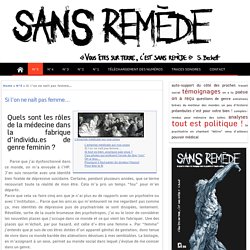
J’en suis ressortie avec une identité bien ficelée de dépressive suicidaire. Certaine, pendant plusieurs années, que ce terme recouvrait toute la réalité de mon être. Cela m’a pris un temps “fou” pour m’en départir. Parce que cela va faire cinq ans que je n’ai plus eu de rapports avec un psychiatre ou avec l’institution… Parce que les ami.es qui m’entourent ne me regardent pas comme ça, mes identités de dépressive puis de psychiatrisée se sont dissipées, lentement. You Probably Haven’t Heard Of These Five Amazing Women Scientists – So Pay Attention. All week I’ve been intrigued and inspired by posters appearing in my department that depict truly great scientists, mathematicians and engineers.

Few of them were known to me or my fellow students, yet their achievements include revolutionising algebra, developing the first treatment for leukaemia, and discovering fundamental processes in physics. Their only common characteristic? They are women, and their appearance on the walls marks International Women’s Day. Try to recall a woman scientist and Marie Curie may be the first and perhaps only name that springs to mind. This is a shameful state of affairs, when for more than a century scientists who happen to be women have reached great scientific heights, despite the many barriers they faced on account of their gender.
So here are five women whose amazing discoveries and contribution to science should be as well-known and respected as those of Marie Curie. Rosalind Franklin – Crystallography Rosalind Franklin. Lise Meitner in 1906. Margaret Hamilton (scientifique) Un article de Wikipédia, l'encyclopédie libre.
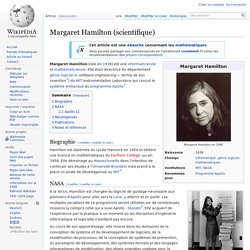
Margaret Hamilton Margaret Hamilton en 1995 Margaret Hamilton (née en 1938) est une informaticienne et mathématicienne. Elle était directrice du département génie logiciel (« software engineering », terme de son invention[1]) du MIT Instrumentation Laboratory qui conçut le système embarqué du programme Apollo[2]. Hamilton est diplômée du Lycée Hancock en 1954 et obtient une licence en mathématiques du Earlham College (en) en 1958. Margaret Hamilton avec son code source écrit pour le programme Apollo. Sud-Ouest ne veut pas voir certaines femmes. Symbiartic, Scientific American Blog Network. The views expressed are those of the author and are not necessarily those of Scientific American.

One of the many reasons I love tumblr is that I find amazing artists like Rachel Ignotofsky. She’s a graphic designer and illustrator currently working at Hallmark Greetings by day and as a freelance illustrator by night. Her work frequently touches on science with layers of the earth, inside a cell, body systems posters, how love works, plant anatomy, Darwin deck, lab equipment, and food chain. “Biology and human anatomy were always my favorite subjects in school,” said Ignotofsky. ”I think there is real beauty in seeing the mechanics behind how the world works.
I want to take that information and make it accessible and fun to learn.” Rosalind Franklin. Un article de Wikipédia, l'encyclopédie libre.
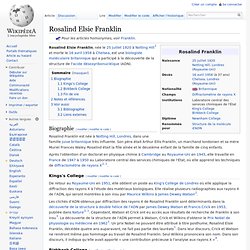
Pour les articles homonymes, voir Franklin. Biographie[modifier | modifier le code] Ogling by Men Subtracts from Women's Math Scores. Getting the once-over from a man causes women to score lower on a math test, a new study finds.
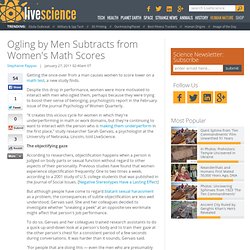
Despite this drop in performance, women were more motivated to interact with men who ogled them, perhaps because they were trying to boost their sense of belonging, psychologists report in the February issue of the journal Psychology of Women Quarterly. Bibliometrics: Global gender disparities in science. Despite many good intentions and initiatives, gender inequality is still rife in science.
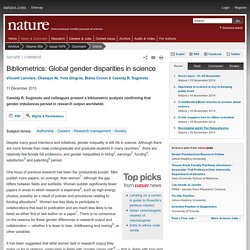
Although there are more female than male undergraduate and graduate students in many countries1, there are relatively few female full professors, and gender inequalities in hiring2, earnings3, funding4, satisfaction5 and patenting6 persist. One focus of previous research has been the 'productivity puzzle'.
Men publish more papers, on average, than women7, although the gap differs between fields and subfields. Women publish significantly fewer papers in areas in which research is expensive8, such as high-energy physics, possibly as a result of policies and procedures relating to funding allocations4. Women are less likely to participate in collaborations that lead to publication and are much less likely to be listed as either first or last author on a paper7. Advance.cornell.edu/documents/nepotism_and_sexism.pdf.
The 'leaky pipeline' of women in science. Why women in science are annoyed at Rosetta mission scientist's clothing. This morning, when Dr Matt Taylor briefed the press on the Rosetta mission, he wore a very plain black T-shirt.

Yesterday, he wore something more colourful. As the Independent reported, “the public marveled over his ‘cool’ attitude. Not since Brian Cox rocked up with a Beatle haircut and soft northern vowels has a scientist become trended so suddenly over such a short period.” It follows a spate of press on this “geezer scientist” who seems like a charming and appealing break from images of labcoats. Except not everyone was so pleased at Taylor’s style.